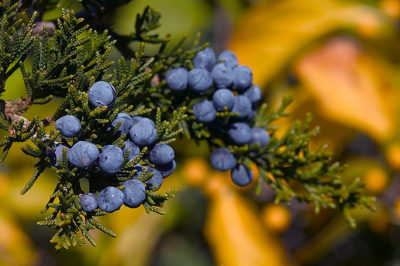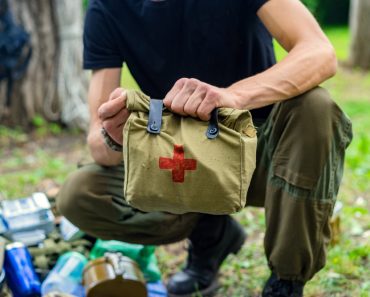
It becomes clear that at certain seasons, trees can provide a wide variety of food supplies.
Survival Trees
When we think of trees in survival situations, we tend to gravitate to the obvious. Trees give us wood for our campfires. They provide structure for shelters, materials from which shelters can be built. These are all accurate perceptions, but survival trees, if you recognize and utilize them correctly, can contribute much more to our chances of survival than just firewood and construction materials.
Consider for a moment the varieties of nut trees that grow on the North American continent. There are hickories, walnuts, buckeyes, pecans, and hazelnuts to name just a few. Then consider the wild fruit trees, from plums to persimmons crab apples to mulberries. I hope it will become clear that at certain seasons, many trees can literally become “survival trees” and provide a wide variety of edible opportunities.
1. Oak Tree
Even the oak tree produces acorns which can be turned into meal or flour; the trick is to leach out all the tannins using a lot of fresh water. After gathering acorns, they must be dried so that the kernels can be removed from the husks. Once this is done, the kernels are ground into meal. After grinding, the meal is repeatedly soaked and drained for up to 6 days. The tannins must be removed from the meal before use, or they can cause stomach problems, kidney problems or inhibition of nutrient uptake. Once properly prepared, however, acorn meal makes fine bread, pancakes, and other baked goods.
Obviously, it is a very good idea to become accustomed to the trees in your area from a food gathering standpoint. But the utility of trees does not stop at fire, shelter, fruits and nuts. If you take a bit more time to learn about your local trees, they can provide other foods, medicines and become survival trees.
2. Willow Tree
One of my favorites is the willow tree. Willow bark is known to be an analgesic, an anti-inflammatory, and a fever reducer. It has been used since ancient time to relieve a headache, lower back pain, Osteoarthritis, fever, Flu, tendonitis, and Bursitis. In the 1800s one of the active compounds in willow bark, salicin, was used to develop aspirin. It has been suggested that willow bark has more pain relieving benefits at lower dosages, and with less chance of side effects, than aspirin.
Pocket Sized Solar Generator Provides Dependable Backup Power
To use willow bark you will need to boil 1-2 teaspoons of dried bark in 8 ounces of water. Simmer for 10-15 minutes and then allow it to steep for 30 minutes. Drink 3-4 cups daily. This bark can also be used to make tinctures, but the tea I have just described is the best method in a survival setting. It is critical to note that just like aspirin, willow bark should not be administered to those under the age of 16 due to the risk of Rye’s Syndrome. Chewing on Birch twigs, according to folk medicine and modern chemistry should yield similar results for pain relief.
3. Juniper
The juniper is another example of a fine medicinal survival tree. Here in the states, many of our junipers are known as cedars. Red cedars, both Western and Eastern, produce juniper berries. Juniper berries are actually very small, tightly compacted cones; more specifically, they are the seed-bearing female cones. The “berries” from this survival tree take 2-3 years to mature, and are ripe when they achieve a purple color. Dried berries have been used for centuries as a seasoning, and are reportedly excellent in conjunction with a variety of wild game. Juniper berries are even responsible for the unique flavor of gin.
4. Eastern Red Cedar
Medicinally, the leaves of the eastern red cedar have been used to treat rashes and skin irritations. Smoke from the leaves can be inhaled to treat colds, bronchitis, and rheumatism. The berries can be chewed to relieve canker sores and toothaches. A tea brewed from the berries can be used to treat colds, worms, rheumatism and coughs.
Story continues below video
https://www.youtube.com/watch?v=UG_gOX4ntvg
Fruits can be chewed to treat canker sores. It has been suggested that red cedar has calmative and anti-spasmodic properties as well, and that it may be used as a nerve tonic, and that it may contain a cancer-fighting agent as well. Now for the disclaimer: It has also been suggested by some that all parts of this survival tree may be considered toxic. As with any alternative medicine, do your homework on this one before trying it. The long history of medicinal use makes me confident, but weigh all the evidence for yourself! No matter what you decide, it is widely accepted that red cedar should not be given to pregnant women as it may cause spontaneous abortions.
5. Sassafras
Sassafras is another great little survival tree. For starters, it is excellent as a fire starter due to the very high concentrations of volatile oils in both the leaves and the wood, and this alone could save your bacon on a wet day when you need a fire in a hurry. Next up, the dried leaves of the sassafras make an excellent seasoning. Known as file powder it was a prime ingredient in the original gumbo. The root of the sassafras was the main ingredient of the original root beer. This little survival tree has had an undeniably huge impact on the culinary arts! It goes even further, though. This amazing tree also has medicinal qualities. It has been hailed as a treatment for Rheumatism, hypertension, scurvy, skin sores, kidney problems, toothaches, swelling and dysentery, to name a few.
Teas brewed from the bark have long been considered an excellent spring tonic to cleanse the system and the blood, and are a fine diuretic. Sassafras, too, comes with a disclaimer. Modern medicine sometimes seems bent on destroying the reputations of traditional or folk remedies, but do your research on this one as well before you make up your mind about it. Infusions should be made by boiling and steeping a tablespoon of root bark in a cup of water and taking not more than a cup a day.
In Conclussion
Trees are a wonderful gift in so many ways. Take the time to get to know the trees in your area and their uses so what seems at first glance to be ordinary, can truly become survival trees in a time of crisis. Knowledge is never wasted, and a little survival tree knowledge could help to save your life one day.
Do you have any beneficial trees you’d like to add to our list? Tell us why in the comments below!


























